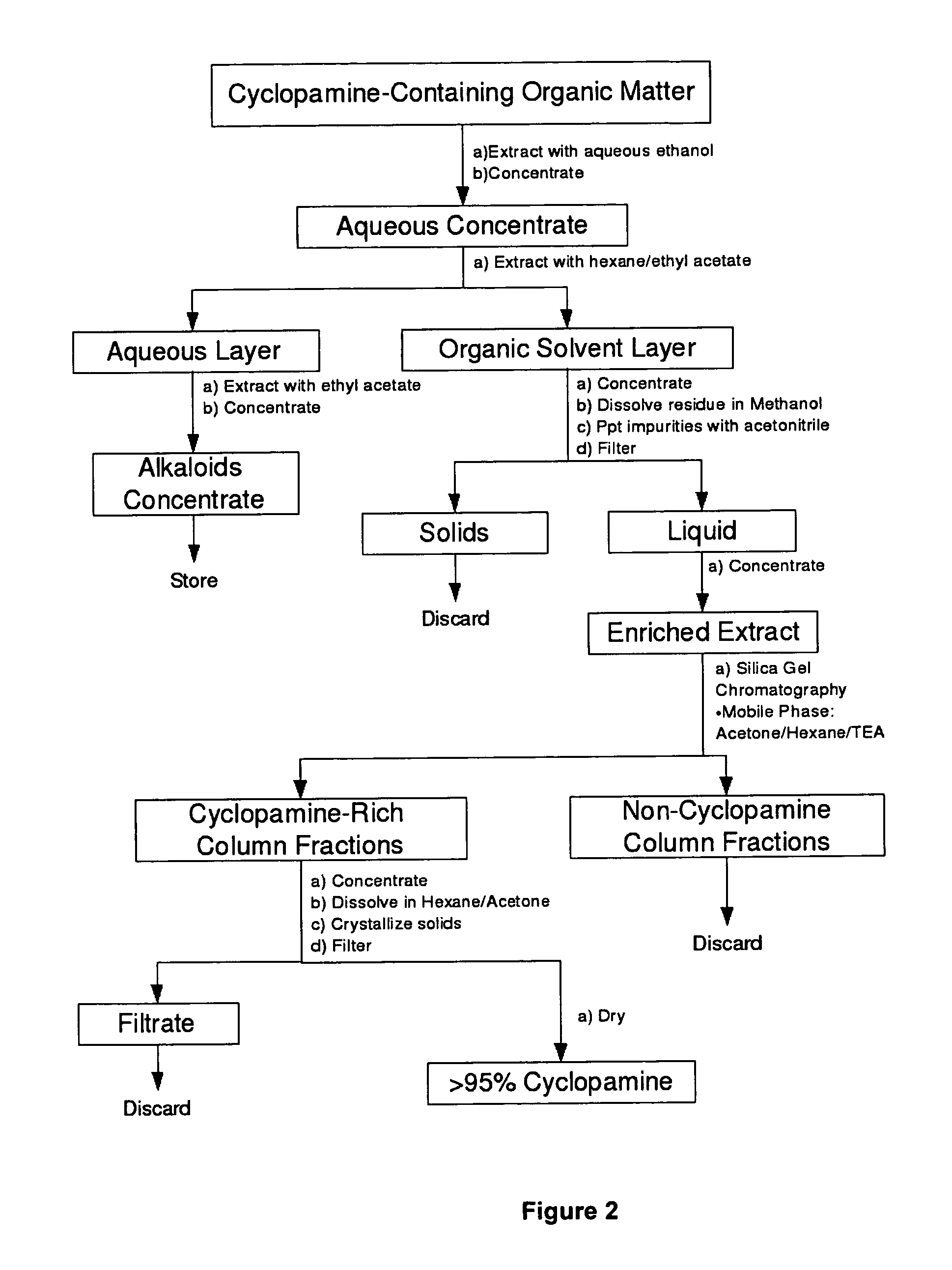Methods for obtaining cyclopamine
a cyclopamine and purification technology, applied in the field of extraction, purification and isolation of cyclopamine, can solve the problems of low recovery of available alkaloids, inability to scale up easily, and process is not scalable to large volumes, so as to ensure the stability of cyclopamine, high purity cyclopamine, and high yield
- Summary
- Abstract
- Description
- Claims
- Application Information
AI Technical Summary
Benefits of technology
Problems solved by technology
Method used
Image
Examples
example 1
[0092]Approximately 25 g of dried, finely ground roots of V. californicum were contacted with 250 mL of different extractant solvent mixtures and slowly agitated at ambient temperature for 4 hours. The extracted solids were then separated from the extract solution by filtration. The extracted solids were washed with a further 50 mL of fresh solvent and the combined extract / wash solution concentrated under vacuum using a rotary evaporator operating at approximated 45° C. to form a dried residue. Samples of the residues were quantitatively analysed for cyclopamine content by RPHPLC against a cyclopamine standard. Table 1 shows the total extract yield obtained (g residue per g of starting dried roots) and the purity of the extract residues obtained (weight % cyclopamine).
TABLE 1Extraction of dried, ground v. californicum roots in different solventsCyclopamineTotal Extract Yieldconcentration inSolvent Mixture(%)Extract (% w / w)hexane + 5% sodium carbonate0.3%2.7%ethanol6.9%1.8%ethanol / wa...
example 2
[0093]Approximately 25 g of dried, finely ground roots of V. californicum were contacted with 250 mL of different extractant solvent mixtures and extracted by microwave-assisted extraction. The root / solvent mixtures were gently agitated in a modified laboratory-scale microwave extractor connected to a condenser system and subjected to 300 Watts microwave energy at 2450 Mhz for 5 minutes. The mixture was then gently agitated for 25 minutes following microwave exposure. The extracted solids were then separated from the extract solution by filtration. The extracted solids were washed with a further 50 mL of fresh solvent and the combined extract / wash solution concentrated under vacuum using a rotary evaporator operating at 45° C. to form a dried residue. Samples of the residues were quantitatively analysed for cyclopamine content by RPHPLC against a cyclopamine standard. Table 2 shows the total extract yield obtained (g residue per g of starting dried roots) and the purity of the extra...
example 3
[0094]Approximately 25 g of dried, finely ground V. californicum roots containing 2.4 g / kg of cyclopamine was mixed with 4.15 g of sodium carbonate and contacted with 250 mL of 67% ethanol / 33% water (v / v). The mixture was placed in a modified laboratory-scale microwave extractor connected to a condenser system and subjected to 300 Watts microwave energy at 2450 Mhz for 5 minutes under gentle agitation. The mixture was agitated for a further 25 minutes following microwave exposure. The extracted solids were then separated from the extract solution by filtration. The extract solution was concentrated under vacuum using a rotary evaporator operating at 45° C. to a volume of approximately 25 mL to form a concentrated first residue aqueous solution. The first residue was combined with 25 mL of 70% hexane / 30% ethyl acetate (v / v) organic solution, mixed for 15 minutes and then transferred to a separatory funnel for 1 hour. The organic phase was collected and the aqueous phase re-contacted ...
PUM
 Login to View More
Login to View More Abstract
Description
Claims
Application Information
 Login to View More
Login to View More - R&D
- Intellectual Property
- Life Sciences
- Materials
- Tech Scout
- Unparalleled Data Quality
- Higher Quality Content
- 60% Fewer Hallucinations
Browse by: Latest US Patents, China's latest patents, Technical Efficacy Thesaurus, Application Domain, Technology Topic, Popular Technical Reports.
© 2025 PatSnap. All rights reserved.Legal|Privacy policy|Modern Slavery Act Transparency Statement|Sitemap|About US| Contact US: help@patsnap.com



